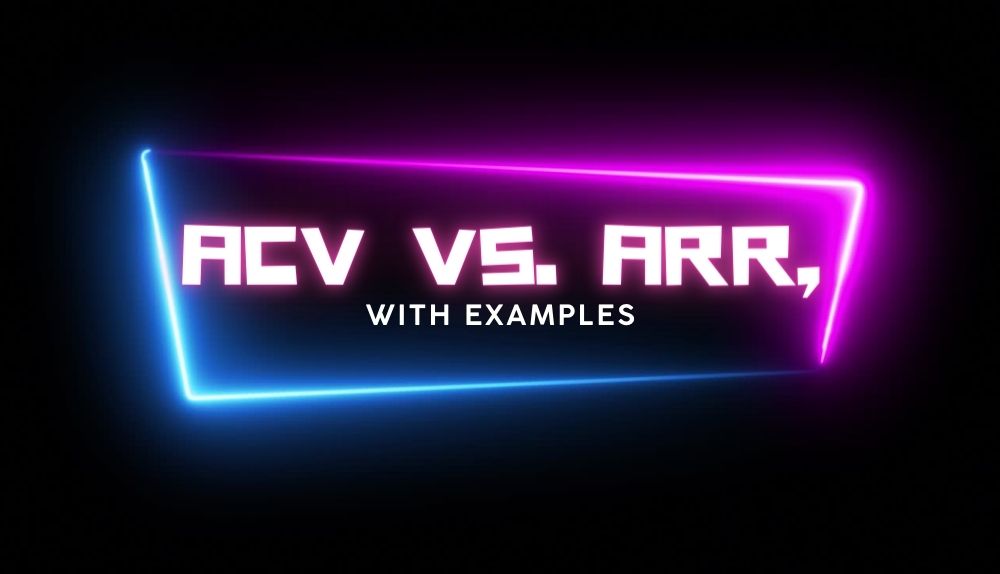What is ACV in Sales? ACV vs. ARR and Examples
You’ll likely come across various acronyms and financial terms when evaluating different funding options for your business. While many are unfamiliar, each represents a unique type of financing that businesses can leverage to help fund their growth. In this blog post, we’ll explain the differences between ACV vs. ARR, and give examples of how they compare.
These three terms cover a range of financing options available to growing businesses. While each has its pros and cons, there is a perfect fit for every business based on its current needs and future ambitions.
What is ARR?
ARR stands for Annual Rate of Return. It is a measure used to determine the profitability of an investment. You can also use it to compare one investment option against another to decide which is better.
Business owners can use ARR to compare the cash flow from different financing options. This is done by calculating the annual return for each option. Annual returns help determine the best financing option for your business.
Let’s say you’re looking for a new line of credit for your business. You can borrow $300,000 at a fixed or variable interest rate. The variable rate has a higher annual percentage rate (APR) but a lower upfront payment.
The fixed rate has a lower APR but a higher upfront payment. To help you decide which option is best for your business, you can compare the two financing options using ARR to determine which provides the highest annual return.
Usage
Because it measures predicted yearly revenue, ARR is a great determinant of financial health. It can also be used to:
● Track revenue growth over time
● Recognize income swings induced by supply-demand, sales, or cancellations to estimate revenue
● Examine and improve your marketing and strategies
If the SaaS business sells monthly fees, you should also track MRR. MRR is multiplied by 12 to calculate ARR.
ARR example calculation
Assume a corporation gains 20 new clients in a particular year, each with a $2,000 subscription value. This results in a total cost of $40,000. However, the corporation also loses five customer subscriptions, totaling $10,000.
During the same year, ten clients upgraded their memberships to a $2,500 contract, resulting in a $5,000 gain in overall value. Meanwhile, four clients elect to drop to a $1,500 membership, resulting in a $2,000 net loss.
This company earns $200,000 per year from its current monthly membership plans.
Let’s plug everything into the ARR equation:
ARR = ($200,000 + $40,000 + $5,000) – $2,000 – $10,000 = $233,000
What is ACV?
ACV stands for Adjusted Capitalized Value. It is a valuation method used to determine the value of a piece of equipment used in producing goods. The ACV is used to help determine the amount of depreciation you can deduct on your tax return.
It is often associated with debt structuring or a financing option that uses the equipment as collateral. For example, let’s say you’re looking to finance new equipment for your business.
You have a few financing options but must determine which is best for your business. By calculating the ACV for each option, you can compare the different financing options side-by-side to help you decide which one is best for your business.
Usage
ACV is an important metric that illustrates the worth of a client’s contract by collecting and altering its valuation over a year.
ACV can be used to determine the valuation of the customer accounts, whether or if they involve:
● Monthly subscriptions are taken into account
● Plans at various price points
● Multiple-year agreements
ACV sales metrics are generally based on ongoing revenue collected by a given client or contract and exclude single or multiple initial setups, administrative costs, or training.
ACV example calculation

Assume Client A agrees to a five-year subscription model worth $15,000. Plug these data into the calculation to compute ACV.
Contract revenue each year = $15,000 5 = $3,000
As a result, the year’s worth of this company’s contract is $3,000. Unfortunately, the calculation is not always so simple.
Assume Client B likewise signs up for a subscription model, but they only require a four-year membership worth $12,000. They also want to add a four-year contract to a subscription fee that costs $100 each month.
First, we’ll calculate the overall worth of the monthly membership service over four years:
In four years, $100 x 48 months = $4,800
Then we can add this to the original contract’s total value.
$12,000 + $4,800 = $16,800
Finally, we’ll divide the entire lease value by the number of years to calculate the annual recurring revenue:
$16,800 ÷ 4 years = $4,200
In this scenario, the contract’s annual value is $4,200 over four years.
What is the Difference Between ACV and ARR?
ARR is a profitability metric comparing the returns of two financing options. ACV is a valuation method used to determine the value of equipment used in production. These are two very different things.
ARR is used to compare the profitability of different financing options. ACV is used to determine the value of equipment used in production. Although these terms may sound similar, they measure and compare very different things.
These two terms are often confused, but they are very different. ARR is a profitability metric that compares the returns of two financing options. ACV is a valuation method used to determine the value of equipment used in production.
Example of how to compare ACV vs. ARR
Let’s say that you’re looking to borrow money for your business. You have two different financing options available to you. You can borrow $300,000 at a fixed interest rate of 8% or $350,000 at a variable interest rate of 10%.
By calculating the ARR for each option, you can compare the different financing options side-by-side to help you decide which one is best for your business. By comparing the profitability of each option, you can see that the 8% fixed-rate loan will give your business the highest annual return.
Next, let’s say that you want to determine the value of a piece of equipment used in producing goods for tax purposes. You have two different options for determining the ACV for this equipment.
You can either use the equipment’s original cost or the equipment or the resale value of the equipment. Again, by comparing the two options, you can see that the original equipment cost is $300,000, and the resale value is $250,000.
Conclusion
Since you know what ARR and ACV imply for a firm, you’ll be successful in finding countless ways to use these two essential metrics to improve team performance.
These three terms cover a range of financing options available to growing businesses. While each has its pros and cons, there is a perfect fit for every business based on its current needs and future ambitions.
By comparing different financing options, you’ll be able to identify which options are best for your business. From there, you’ll be able to make the best decision to help your business grow and succeed.











